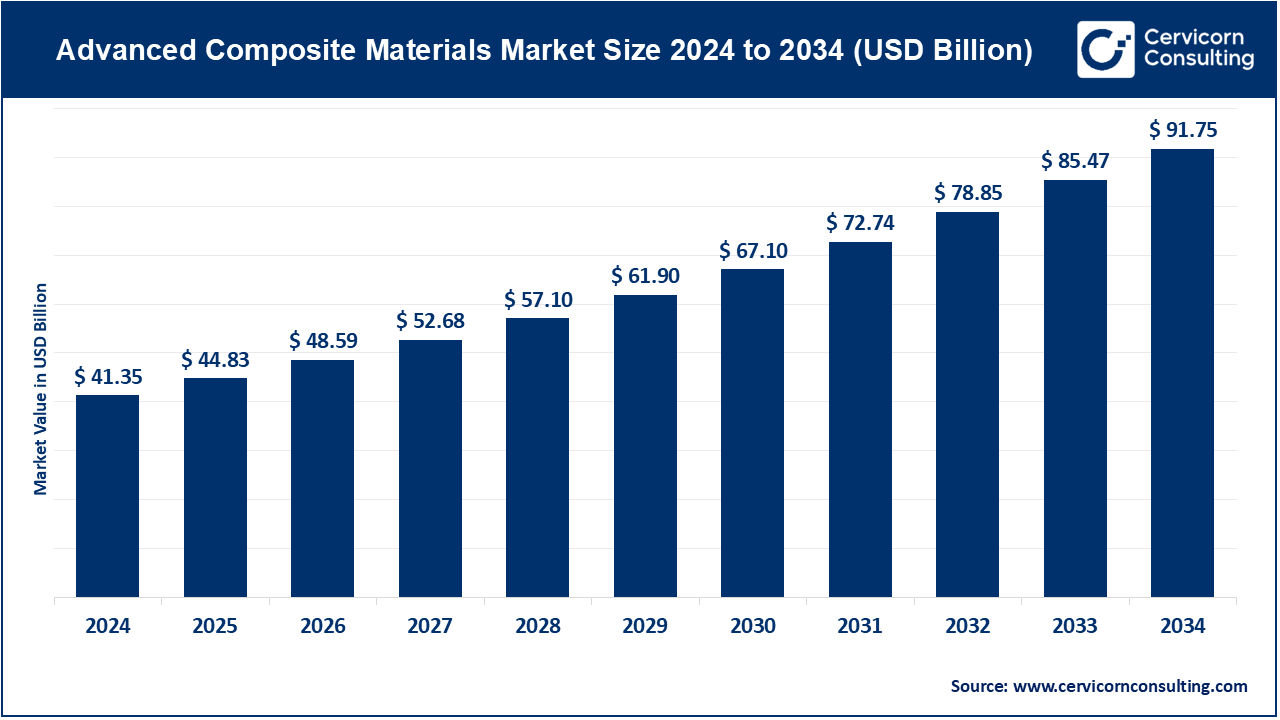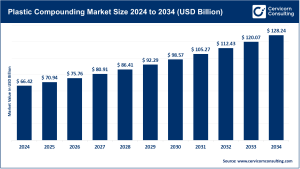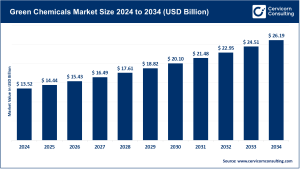Advanced Composite Materials Market Overview
In 2024, the global advanced composite materials market stood at USD 41.35 billion and is projected to reach USD 91.75 billion by 2034, advancing at a CAGR of 8.40% between 2025 and 2034. While North America accounted for the largest share in 2024, the Asia-Pacific region is expected to post the fastest growth. Among product categories, carbon-fiber composites dominate the market share.
Key Market Trends
-
Rising demand for lightweight solutions in transportation
Both aerospace and automotive manufacturers are moving away from traditional metals, turning to composites to enhance fuel efficiency and extend the driving range of EVs. This transition has accelerated the use of carbon fiber and structural composites in critical load-bearing components. -
Carbon fiber leadership and capacity expansion
With carbon fiber contributing to around 66% of revenue share in 2024, increasing investments in production and large-scale capacity expansion are making the material more accessible, especially for high-volume automotive applications. -
Technological advancements in manufacturing
Cutting-edge processes such as automated fiber placement, resin transfer molding, and 3D printing are reducing cycle times and production costs. This is widening the scope of composites across sectors like automotive, renewable energy (wind), and electronics. -
Sustainability and regulatory push
Stricter environmental norms are boosting the adoption of recyclable thermoplastic composites, bio-based fibers, and hybrid solutions. Additionally, ceramic matrix composites are becoming increasingly important in aerospace and energy industries for high-temperature applications. -
Smart and functional composites
The integration of sensors and adaptive features into composites is enabling structural health monitoring and multi-functional performance, unlocking new opportunities in aerospace, urban air mobility, and infrastructure projects.
👉 Get a Free Sample: https://www.cervicornconsulting.com/sample/2359
Market Drivers
-
Aerospace & Defense: Lightweight, fuel-efficient designs continue to propel demand for advanced composites in aircraft and defense platforms.
-
Automotive Lightweighting & Electrification: EV producers rely on composites to reduce vehicle weight and extend battery range.
-
Renewable Energy (Wind): The need for longer, stronger turbine blades drives demand for both glass and carbon fiber.
-
Manufacturing Innovations: Automated and cost-efficient processing methods are facilitating broader market penetration.
-
Infrastructure & Construction: Composites offer durability and corrosion resistance, making them ideal for bridges, marine vessels, and civil structures.
Impact of Trends & Drivers
-
By product type: Carbon fiber leads due to its superior strength-to-weight ratio, while glass fiber maintains relevance in cost-sensitive wind energy and construction. Advanced materials like ceramic and metal matrix composites are expanding into aerospace and energy.
-
By application:
-
Aerospace & Defense: Increasing role of carbon and ceramic composites in high-performance parts.
-
Automotive: Rising EV demand fuels the use of composites in lightweight panels and chassis.
-
Wind & Marine: Enhanced use of glass and carbon fibers in longer turbine blades and marine-resistant structures.
-
-
By region: North America benefits from established aerospace and industrial sectors, while Asia-Pacific is gaining traction through EV expansion, renewable projects, and new production facilities.
Challenges & Opportunities
Challenges
-
High production and material costs compared to metals.
-
Recycling and end-of-life limitations for thermoset composites.
-
Inconsistent global standards for certification and compliance.
Opportunities
-
Scaling up carbon fiber production to lower costs.
-
Development of recyclable thermoplastic composites to meet sustainability goals.
-
Growth in emerging sectors such as medical devices, smart electronics, and next-generation infrastructure.
Future Outlook
The advanced composite materials market is set for significant growth, fueled by lightweighting trends, renewable energy demand, and cost-effective manufacturing. Expansion is anticipated in EVs, wind energy, aerospace, and Asia-Pacific markets. Future developments will likely center on recyclability, automation, and the integration of smart composite technologies, shaping the next decade of innovation.
👉 Contact for Detailed Market Insights: https://www.cervicornconsulting.com/contact-us


